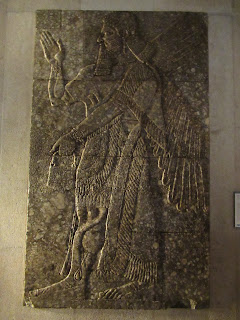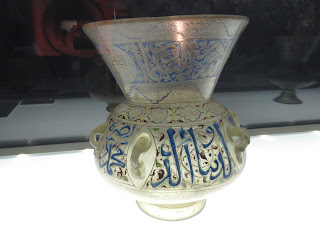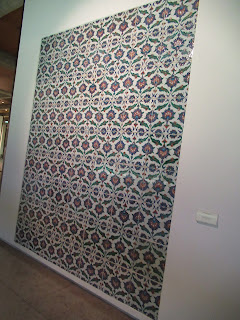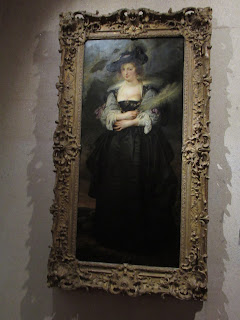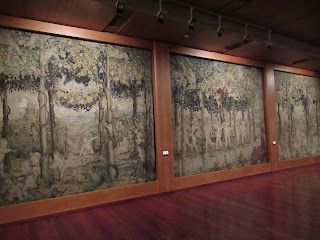About a month ago I returned from being away on vacation with a friend in New Zealand and Australia for 3.5 weeks. In case you also want to follow that really fun trip, here's a link to the newest blog:www.bergersadventures7.blogspot.com
Earlier in the day Steven and I had had a really great day exploring Lisbon's Belem neighborhood with its wealth of museums from the country's Golden Age when the tiny nation controlled so much of the world. Luckily, we'd saved enough time to seek out the Gulbekian Museum, considered the best of the city's 40 museums. The art museum, located two miles north of the city center, was named for Calouste Gulbekian (1869-1955), an Armenian oil tycoon who gave his immense art collection to Portugal as thanks for the asylum he was granted while living in Lisbon during WW II.
According to travel writer Rick Steves, Gulbekian is considered to be "an inspirational model of how to be thoughtfully wealthy. He made a habit of 'tithing for art,' spending ten percent of his income on things of beauty, and his billion-dollar estate is still a vital arts foundation promoting culture in Portugal." His huge collection spanned 5,000 years of European, Egyptian, Islamic, and Asian art.
Earlier in the day Steven and I had had a really great day exploring Lisbon's Belem neighborhood with its wealth of museums from the country's Golden Age when the tiny nation controlled so much of the world. Luckily, we'd saved enough time to seek out the Gulbekian Museum, considered the best of the city's 40 museums. The art museum, located two miles north of the city center, was named for Calouste Gulbekian (1869-1955), an Armenian oil tycoon who gave his immense art collection to Portugal as thanks for the asylum he was granted while living in Lisbon during WW II.
According to travel writer Rick Steves, Gulbekian is considered to be "an inspirational model of how to be thoughtfully wealthy. He made a habit of 'tithing for art,' spending ten percent of his income on things of beauty, and his billion-dollar estate is still a vital arts foundation promoting culture in Portugal." His huge collection spanned 5,000 years of European, Egyptian, Islamic, and Asian art.
This monumental limestone sculptural group, called the Homage to Jean Goujon, was produced by French artist Alfred-Auguste Janniot during his studies in Rome from 1919-1924. When he returned to France, the grouping was exhibited outside the most visited pavilion in the 1925 Paris International Exhibition of Decorative Arts. Janniot's name became the symbol for the Art Deco period and artistic movement. Calouste Gulbekian acquired the work in 1939 to place it in the gardens of his property.
There were two wings off the entrance lobby: the pre-1500 and the post-1500; we began in the former, preferring to follow the museum's mostly chronological layout. That meant starting with Gulbekian's ancient Egyptian treasures which dated from 2500-500 BC. As the Egyptians from long ago believed that life really began after death, they carved statues to preserve the memory of the dead, whether it was a prince or a family pet. The compact limestone Egyptian piece, called the Statuette of the Official Bes, came from the early 26th dynasty which lasted 660-610 BC. The inscription called Bes "the king's friend."
The bronze Cat with Kittens was from the 26th dynasty, i.e. 664-525 BC. The cat was shown nursing her kittens atop a coffin that used to hold the cat's mummy so it was preserved for the afterlife. Egyptians liked to honor cats as they believed the cats helped the goddess Bastet keep watch over the household. Cats were so highly prized that cats were given gold earrings! This mother cat's ears were even pierced.
This Egyptian Funerary polychrome ebony statue was from the Middle Kingdom's 11th dynasty which was about 2000 BC. It was hard to fathom what phenomenal condition it was in all these millennia later.
In the Greece and Rome Gallery (500 BC-500 AD), this beautiful terracotta Vase from circa 440 BC Greece was painted using the red-figure technique over a black background. The surface was divided into two horizontal sections using mythological themes. The scenes portrayed half-human satyrs chasing human women. I read it was designed to remind people of "the rational Greeks' struggle to overcome their barbarian, animal-like urges as they invented Western civilization."
Any satyr sculpture or monument Steven and I've seen in the past has appeared very ferocious and always with a scowl. That's why I was surprised at how friendly this Roman Satyr's Head from the mid-2nd century AD was.
The 9th century BC alabaster Bas-Relief came from the Northwest Palace in Nimrud, Assyria, now modern-day Iraq. It represented a bearded genie with the right hand raised in adoration and the left holding a smaller vessel containing purifying water. An engraved Assyrian inscription crossed over the genie with no regard to the sculpture, according to the custom of the scribes of the period. The text, a kind of summary of the great inscriptions of the kings, began with a long enumeration of the protecting gods and the titles of the monarch.
This golden marvel depicted a bust of Alexander the Great (336-323 BC) wearing a jeweled crown or diadem with a round shield on one side. On the other, was Alexander's head with a ram's horn. Alexander used war to spread Greek culture throughout the Mediterranean, creating a cultural empire that would soon be taken over by Roman emperors.
Other magnificent coins:
In the Islamic World Gallery (700-1500), we got to see items from all over the Islamic world Muslims might have decorated their homes with as they lived in Portugal which was as far west of Mecca as you could get back then. The Bowl with Birds in Mirror Profile came from the late 13th century or early 14th century Iran, a country Steven lived in for two years and which we would both love to visit together if at all possible.
No collection of items from the Islamic part of the world would be complete without a stunning wool Isfahan Carpet from 16th-17th century Persia.
I think the most spellbinding items we'd seen so far were the Glass Mosque Lamps - not only were they beautiful, there were actually Arabic quotes from the Koran on them. One said "Allah is the light of the world, shining like a flame in a glass lamp, as bright as a star."
Not to be outdone was this lovely, painted Tile Panel from the second half of 16th century Turkey during its Ottoman period.
Two more spectacular tile panels from the same period:
Some other lovely items from the Iznik area of Turkey, also from the 16th century, really grabbed my attention as I love pottery, especially anything in the rich, cobalt blue color.
The Far East Gallery (1368-1644) was the next area of the world where Gulbekian amassed a wealth of items. For almost 300 years, the Ming dynasty ruled China, having reclaimed the country from Genghis Khan and his sons. When Portuguese traders reached the Far East, they brought back blue and white ceramics. In time, they became all the rage and helped inspire the creation of both Portuguese tiles and Dutch Delftware. (Steven and I looked forward to seeing the latter on a day trip from Amsterdam to Delft in about two weeks!)
The Three Jars and Two Vases came from the mid-18th century Qing dynasty.
Interestingly, these early 18th century porcelain pieces were called Pairs of Lions or Fo Dogs - did that mean they were lions or dogs?!
Wouldn't it be amazing to have this late 17th century wood, lacquer and paper Coromandel Screen from China displayed in your home?! It was so beautiful.
This 19th century Japanese Silk Hanging was a stunner, too.
This 18th century Edo Period Japanese box was the ultimate picnic basket and perfect for an excursion to the Japanese countryside.
We then crossed into the next wing which focused on European art starting with the Medieval Europe Gallery (500-1500). While China was thriving and inventing, Europe, according to Rick Steves, was "stuck in a thousand-year medieval funk with the exception of Muslim Arab-ruled Spain and Portugal." Most Europeans from this 'Age of Faith' placed their spirituality into objects of Christian devotion. This 14th century Flemish diptych (i.e. two screens) showed the Coronation of the Virgin, Washing of the Feet, Crucifixion and the Ascension.
The 12th century Italian portrayal of Christ was created from chased and gilded bronze.
The triptych of Scenes from the Life and Death of the Virgin by an unknown French artist was made of elephantine ivory with traces of polychrome. One like this enabled a priest traveling on horseback from one remote village to another that had no church to deliver a sermon as he had his own altar piece with him.
In monasteries, the monks with the best penmanship copied books called Books of Hours and decorated them with scenes from the text. These Christian devotional books were initially written in Latin and commissioned by wealthy members of the nobility and of the rising bourgeoisie. The books were like time capsules as they preserved the knowledge of Greece and Rome until those cultures could reemerge a thousand years later in the Renaissance.
The next part of the enthralling museum focused on Renaissance and Baroque Painting from 1500-1700. When the birth of humanism began around 1500, painters began viewing God in the faces of ordinary people. An example of that was this oil portrait of a wrinkled old woman by the Dutch artist, Frans Hals, about 1626.
Another, by Rembrandt in 1645, was the Portrait of an Old Man whose crease-lined hands told the story of his life.
These next two were described as being 'lesser works' by Peter Paul Rubens but I confess to not knowing what constituted his major versus lesser works.
For a long time, I've been intrigued by glorious tapestries from long ago so these early 16th century Italian ones called The Dance were particularly captivating.
It was quite a change from having viewed so many fabulous paintings and tapestries in the previous galleries to displays of furniture once owned by French kings Louis XIV, XV and XVI and Marie Antoinette and Madame Pompadour! The heavy, ornate, gilded furniture or that with animal-clawed feet was from Louis XIV's time.
The lighter, daintier and Asian-themed style was a feature of Louis XV.
Seeing such fabulous furniture was like being treated to our very own Home Show!
It was fun listening to which clocks still worked in a room full of them! This 18th century bronze Mantel Clock called Saint Germain after an area in Paris was made by a master clock maker in 1748.
The style fashionable during the time of Louis XVI was stripped-down, tapered and more modern such as this set.
This French, bronze clock with a globe supported by cherubs and the time marked by a golden snake tongue was very striking and the loudest!
From clocks we moved to the era of Romantic to Impressionist Paintings which spanned three hundred years from 1700-2000. When Europe ruled the world, art became increasingly refined. Young British aristocrats, like those shown in the portraits below painted by Thomas Gainsborough, did the European Grand Tour to see the most famous sights.
The Wreck of a Transport Ship by English painter John Turner in 1810 depicted a stormy shipwreck that was evocative of the Romanticism style.
Ivy: You would have enjoyed seeing Boats painted by Claude Monet in 1868 since you're such a big fan of the French artist.
I'd never heard of French artist Pascal-Adolfe-Jean Dagnan-Bouveret but was very drawn to the 1887 composition of Les Bretonnes au Pardon. At the end of the 19th century, artists were seduced by the suggestive power of the ancestral traditions of Brittany's peasants, one of which was the religious Pardon ceremony which dated back to the 15th century.
Celebrated French sculptor Auguste Rodin created the impressive statue of Jean d'Aire, Burger of Calais, in 1913 and the bust of French writer Victor Hugo in 1866.
The breath of fresh air simplicity typical of the Realism style was evident in the 1863 Self Portrait by Edgar Degas and the subsequent charming paintings by Mary Cassatt and Edouard Manet.
What a pretty piece by another artist, Sir Edward Burne-Jones, I was unfamiliar with. The title was The Mirror of Venus.
Almost the last part of the museum's main building was the sumptuous Art Nouveau glass work and jewelry of French designer Rene Lalique (1860-1945) whom Gulbekian counted among his circle of friends. Art Nouveau borrowed forms from nature as you can see in the Horseman Vase and Mice Vase. I wondered who would ever want a vase with mice on it!
Can you even imagine using paperweights like these drop-dead gorgeous pieces?
Look below at how Lalique fashioned ordinary dragonflies, orchids and beetles into breathtaking works of art when they were fashioned into jewelry and hair ornaments. You'll be stupefied by his brilliance! Post a comment below letting me know which piece is your favorite and why.
Gulbekian amassed the largest set of jewels by Lalique. I felt the small Lalique gallery was worth the admission price alone as the pieces were simply gorgeous.
One of, if not the most stunning sculpture gallery I'd ever seen was at the Gulbekian Museum as there were probably about forty impressive sculptures in just one room which were all grouped by their positions: standing, intertwined, nursing, etc. The first ones we admired were the timeless theme of the standing, upright or moving figures that were not always traditional male models.
Houdon's Apollo, sculpted in 1790, was considered as one of the most important works of the ancient world for its "classical inspiration in pose, theme and style" and because its composition refers to the famous Apollo Belvedere at one of the Vatican museums.
It was mind boggling to learn that Rodin was denied access several times to the top art school in Paris. He ended up moving to Italy in 1875 where he came into contact with Michelangelo's work, an artist who exercised a profound influence over him. That same year Rodin began The Age of Bronze composition described as "a life-sized, innocent figure which awakens at the dawn of humanity - a work which incorporates a clear challenge of modernity to the idealistic interpretation of the standing figure. "
As any sculpture formed of more than one figure constitutes a group, that brought up the complex question of the relationship the artist tried to establish with the theme of the union of two or more represented bodies in the Intertwined group. Some of the intertwined figures constituted and endless source of inspiration in the history of art.
The set of sculptures in the Nursing section recalled the extent that the theme of maternal feelings was present in French art during the 1870s. These themes were often suggested to the sculptors by their own family circles. After the Franco-Prussian War of 1870-1, the representation of the child, just like that of the mother, became a central theme.
The last section in the Sculpture Gallery was devoted to Crouching figures. The individual figure called Crouching Flora by French sculptor Jean-Baptiste Carpeaux in 1870 was a feminine figure simultaneously revealing and hiding herself. It was inspired by a life model for the realistic representations of the face. The artist intended for people to walk around her to be enveloped in her beauty which was like the last sight of the classic style of the crouching figure.
It was hard to grasp that only about one sixth of the Founder's Collection was on display at any one time. If we were ever to return to Portugal as we hope to, I would certainly want to stop again at the Gulbekian Museum as it would be like seeing a brand-new museum! The collections in their diversity and quantity gave us a spectacular view of art and craftsmanship throughout the world and across so many cultures. I appreciated how works by world famous artists were placed right by those by less well known but no less stunning pieces.
The Museum's Modern Collection was a five minute walk through an enchanting park filled with bamboo plants and ponds with ducks. It featured the largest and most complete collection of modern and contemporary Portuguese art that was acquired by the museum's foundation after Gulbekian's death.
We only took the time to view the items on the first floor as the day had been long enough already since starting that morning in Belem and modern art is not normally 'our thing.' The first floor was devoted to sculpture which the museum described was suited to the commemoration of people and events.
I couldn't resist taking a photo of the Wood Door from the Artist's Studio that was created by Nuno Sousa Vieira in 2008!
This 2005 piece by Francisco Tropa was titled Untitled!
I couldn't for the life of me grasp the meaning behind this 1967 series called The Ghost of Avignon by Antonio Areal. If you can, please enlighten me.
While taking the subway back to our apartment at the end of a long day, we were reminded that "All you need is art." I hope I have managed to persuade some of you who may visit Lisbon at some point in the future to make a beeline for the Gulbekian Museum - you'll be so glad you did!
Next post: Our last day exploring Lisbon via the fun tram!
Posted on April 29th, 2019, from a snowy day in Denver's suburb of Littleton.









